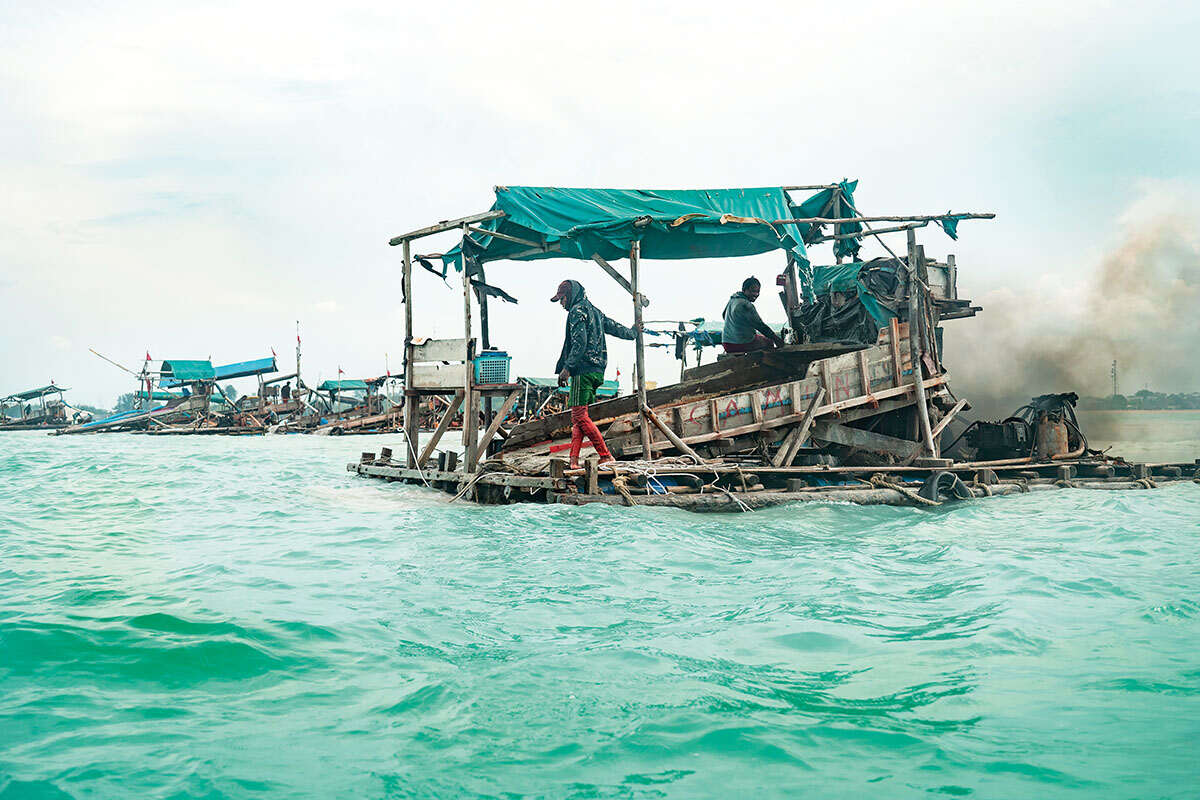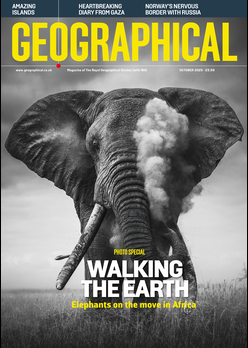
A small Indonesian island is one of the biggest producers of tin. Over the decades, its extraction has caused devasting environmental damage. Now the industry is rapidly moving offshore, continuing to leave a trail of destruction in its wake
Report by Arnaud Guiguitant, Photographs by Guillaume Collanges
The first thing that strikes you when you walk along the coastline adjacent to Batu Belubang, a village on Bangka, a large island off the southeastern coast of Sumatra in Indonesia, is the colour of the Java Sea. Rather than the tropical azure blue you would expect, the water is brown and cloudy, polluted by sand pumped up from the sea floor. ‘Look in the distance,’ says Uday Ratno, who works for WALHI, Indonesia’s largest and oldest environmental-advocacy NGO, gesturing at a vast armada of rickety boats and rafts. ‘All these rafts are digging the seabed for tin. In an hour of drilling, they can dump up to 200 cubic metres of sand.’
How many were there that day? The number is difficult to calculate as they’re scattered as far as the eye could see. The makeshift rafts, built from bamboo and recycled material, carry up to three miners. Hacan, 33, spends ten hours a day at sea amid the din of the pumps that suck up the sand. ‘This area is known as the Beach of a Thousand Rafts,’ he says. ‘It is very rich in tin. Every day I extract up to ten kilos.’
He can sell his daily haul for the equivalent of £45. Tin is a commodity in great demand – every smartphone contains a few grams and it’s used as solder in many other electrical goods. Indonesia is the world’s second-largest tin producer after China, and 90 per cent of that comes from Bangka and its sister island, Belitung.

The islands produce more than 80,000 tonnes annually. Since the early 18th century, Bangka’s rich alluvial deposits of the tin oxide cassiterite have been exploited. A long, boot-shaped belt of the deposits stretches from Myanmar through Thailand, Malaysia, Singapore and Indonesia, with Bangka being the toe.
The island’s population in the 2020 census was 1,146,581, and more than 60 per cent of the local economy depends on tin mining.
Farther out to sea, we see old fishing boats converted into floating factories. These larger vessels can exploit the rich tin deposits on an industrial scale. A wave from the crew chief of one vessel is an invitation to come aboard. ‘Be careful where you step,’ warns Hari Putri, a former fisher who has been a miner for ten years. On the deck, what was once a fish-storage area is now occupied by the mesh belts and machines that feed the pumps. There are five miners on board, including a diver.

Wearing a mask and breathing through a hose placed in his mouth, Abdul Rahman, 36, works on the seabed, ten metres deep, for two to three hours at a time. ‘It’s dangerous, but it’s worth it,’ he says.
In the same manner as the mining on land, which has devasted the island, the offshore extraction is carried out by a chaotic mix of large corporations, sub-contractors, some legal, many not, and even desperate individuals sifting the sand on the beaches in the hope of earning enough to eat. The biggest company is state-owned PT Timah, which mines nearly 30,000 tonnes of tin annually. Director of operations Alwin Albar says the future for the industry is now offshore. The company estimates that known tin reserves on land are 16,399 tonnes, while there are 265,913 tonnes offshore.

The company doesn’t skimp on resources, with exploration vessels, offshore platforms and pump boats. Part of its fleet is the KIP 11, an 82-metre-long boat drilling off Sungai Liat on the east of the island when we visited. At the helm is Captain Mysianto. As he heads for the lower deck where the heart of the extraction system is located, he tells us: ‘At the moment we are digging at a depth of 18 metres. A pump sucks up the sand, which is sifted on the upper deck by mechanical arms. With this method, 600 kilograms of tin are extracted per day.’ This deposit will be exploited 24 hours a day until it’s depleted. As we leave the boat, we see a huge slick of mud drifting for hundreds of metres in its wake. The captain declines to comment on the environmental consequences.
For Uday Ratno from WAHLI, the situation is dire. ‘The sedimentation has a real impact on the Bangka ecosystem,’ he explains. ‘The sand covers everything, including the coral reefs, which end up dying. As a result, fish are forced to change habitat and move further offshore.’
The island’s 45,000 fishers are exasperated with the mining industry. In the village of Matras, the fishing sheds are decorated with placards used during demonstrations in front of the governor’s palace to demand a halt to mining and protection of the coastline. ‘The fish production has dropped sharply,’ says Darman, 58, who has spent 34 years at sea. ‘Before, here, I could catch several dozen kilos of squid and mackerel. Now I can barely catch two kilos. I have to go further from the coast, but it costs me more in fuel.’


Squatting in his boat, Yaman, 40, is preparing his gear for the night’s fishing trip. For years, he has seen the ravages of drilling on the underwater environment. He tells us: ‘Some species of fish have disappeared from our coasts. Why are the authorities waiting to act? The mines are destroying our resources and our way of life.’
He says that he’s ready to ‘fight to the bitter end’ to get ‘the local government to intervene’. ‘We hope they will ban new concessions,’ he says. ‘They must understand that our trade is in danger and that it must be protected. The mines must disappear.’
In the north of the island, Kelabat Bay is home to several once-busy resort islands for tourists, such as Pulau Putri (‘Princess Island’ in Indonesian). Until a few months ago, it was surrounded by rafts and boats drilling into its seabed. Ari Dharmansyah, a member of the environmental NGO Kompala, tells us: ‘The mines are devouring Bangka. The ecological situation at sea is serious. We are engaged in a real rescue operation with the transplanting of more than 100 coral colonies. The government must take the measure of the disaster that is taking place. It must create jobs on the island, in addition to the mining industry. We did not inherit this island – we are borrowing it and we must pass it on to the next generation.’








